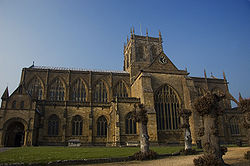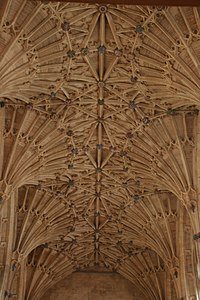Sherborne: Difference between revisions
Created page with ':''Not to be confused with Sherborne, Gloucestershire'' {{Infobox town |name=Sherborne |county=Dorset |picture= Sherborne abbey.jpg |picture caption= Sherborne Abbey |pop…' |
No edit summary |
||
| Line 1: | Line 1: | ||
{{Hatnote|Not to be confused with [[Sherborne, Gloucestershire]]}} | |||
{{Infobox town | {{Infobox town | ||
|name=Sherborne | |name=Sherborne | ||
Latest revision as of 12:12, 7 August 2014
| Sherborne | |
| Dorset | |
|---|---|
 Sherborne Abbey | |
| Location | |
| Grid reference: | ST638165 |
| Location: | 50°56’57"N, 2°31’6"W |
| Data | |
| Population: | 9,350 (2001) |
| Post town: | Sherborne |
| Postcode: | DT9 |
| Dialling code: | 01935 |
| Local Government | |
| Council: | Dorset |
| Parliamentary constituency: |
West Dorset |
Sherborne is a pretty market town in north-western Dorset. It stands on the River Yeo and the A30 road, on the edge of the Blackmore Vale, 6 miles east of Yeovil.
Sherborne is famous for its history, including its abbey, castle, manor house and private schools.
Much of the town, including many mediæval and Georgian buildings, is built from distinctive ochre ham stone, including the Abbey.
The town is served by Sherborne railway station.
History
The town was named scir burne by the West Saxon inhabitants, a name meaning "clear stream", and is appears as such in the Domesday Book.

The Kings of Wessex on occasion held court in Shaftesbury and King Alfred's elder brothers King Ethelbert and King Ethelbald are buried in the abbey. In 705 the Wessex bishopric was split between Sherborne and Winchester, and King Ine founded an Abbey here for St Aldhelm, the first bishop of Sherborne.
The Bishop's seat was moved to Old Sarum in 1075 and the church at Sherborne became a Benedictine monastery. In the 15th century the church was deliberately burnt down during tensions between the town and the monastery, and was rebuilt between 1425 and 1504, though some of the Norman structure remains.
In 1539 the Abbey was dissolved and its church was bought by Sir John Horsey and became a conventional church.

In the 12th century Roger de Caen, Bishop of Salisbury and Chancellor of England, built a fortified palace in Sherborne. The palace was destroyed in 1645 by General Fairfax, and the ruins are owned by English Heritage.
In 1594 Sir Walter Raleigh built an Elizabethan mansion in the grounds of the old palace, today known as Sherborne Castle.
Sherborne was also home to Captain Christopher Levett, a Yorkshireman who came to the West Country as His Majesty's Woodward of Somersete, and who remained in Sherborne as he turned to a career as a naval captain and early explorer of New England.[1]
Sherborne Abbey


Though the monks are long gone, the abbey church in Sherborne retains it old name and now serves as the parish church.
The Abbey is in initial appearance an example of perpendicular Gothic architecture and fine execution; the soaring ceiling is one of the most spectacular examples in the land. However the thinckness of the pillars and rounded arches at the crossing is a clue to an earlier origin, namely that this part and much else is a Norman Romanesque structure, the hefty pillars now clad about and brought into the light Gothic which rises into the high ceiling. Even earlier is the Anglo-Saxon doorway in the west end of the church.
Famous schools
There has been a school in Sherborne since the time of King Alfred, who was educated there. The school was refounded in 1550 as King Edward's public school, using some of the old abbey buildings, though it is now known simply as Sherborne School.
The school remains one of the top fee-paying schools in Britain, boasts numerous successful alumni, including Alan Turing, Jeremy Irons, Chris Martin and John le Carré. Until 1992 there were also two Grammar Schools, Foster's School for boys and Lord Digby's School for girls.
The tradition of education within the town was continued with the founding of Sherborne School For Girls (now known as Sherborne Girls) in 1895, another leading Independent School. Eminent past pupils of Sherborne Girls include soprano Emma Kirkby actress Maria Aitken and novelist Santa Montefiore.
A few miles out of the town, there is also the Roman Catholic all-girls boarding school, Leweston School, which was established in 1948 at Leweston Manor. More recently, the other senior schools established in Sherborne are The Gryphon School and the Sherborne International College (for children from overseas).

Historical buildings
Other notable historical buildings in the town include the Almshouses of Saints John the Baptist and John the Evangelist, founded in their current form in 1438 and expanded in the Victorian Era in indistinguishable mediæval style architecture. The Conduit, Hospice of St Julian, and Lord Digby's school, now known as Sherborne House are also well preserved old buildings in the town.
Sherborne House was a subject for the BBC's "Restoration" program, but failed to win its round. In September 2010 it was shrouded in scaffolding.
References
- ↑ Baxter, James Phinney; Levett, Christoper. Christopher Levett, of York, the pioneer colonist in Casco Bay. Portland, Maine, USA: Gorges Society. http://books.google.com/books?id=gwKwEbZhv3cC&pg=PA7&dq=%22christopher+levett%22+sherborne&lr=&ei=HdwbSbiCG4OGsgPVgs2JDA#PPA7,M1. Retrieved 2008-11-13.
Books
- Pitt-Rivers, Michael, 1968. Dorset. London: Faber & Faber.
- The 1985 AA illustrated guide to the towns and villages of Britain.
Outside links
| ("Wikimedia Commons" has material about Sherborne) |
